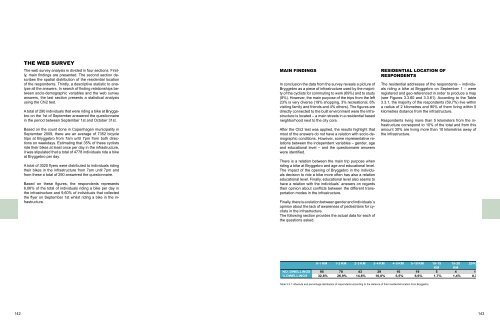Aalborg Universitet Bike Infrastructures Report Silva, Victor ... - VBN
Aalborg Universitet Bike Infrastructures Report Silva, Victor ... - VBN
Aalborg Universitet Bike Infrastructures Report Silva, Victor ... - VBN
Create successful ePaper yourself
Turn your PDF publications into a flip-book with our unique Google optimized e-Paper software.
THE WEB SURVEY<br />
The web survey analysis is divided in four sections. Firstly,<br />
main findings are presented. The second section describes<br />
the spatial distribution of the residential location<br />
of the respondents. Thirdly, a descriptive statistic to analyze<br />
all the answers. In search of finding relationships between<br />
socio-demographic variables and the web survey<br />
answers, the last section presents a statistical analysis<br />
using the Chi2 test.<br />
A total of 290 individuals that were riding a bike at Bryggebro<br />
on the 1st of September answered the questionnaire<br />
in the period between September 1st and October 31st.<br />
Based on the count done in Copenhagen municipality in<br />
September 2009, there are an average of 7352 bicycle<br />
trips at Bryggebro from 7am until 7pm from both directions<br />
on weekdays. Estimating that 35% of these cyclists<br />
ride their bikes at least once per day in the infrastructure,<br />
it was stipulated that a total of 4778 individuals ride a bike<br />
at Bryggebro per day.<br />
A total of 3020 flyers were distributed to individuals riding<br />
their bikes in the infrastructure from 7am until 7pm and<br />
from these a total of 290 answered the questionnaire.<br />
Based on these figures, the respondents represents<br />
6,06% of the total of individuals riding a bike per day in<br />
the infrastructure and 9,60% of individuals that collected<br />
the flyer on September 1st whilst riding a bike in the infrastructure.<br />
MAIN FINDINGS<br />
In conclusion the data from the survey reveals a picture of<br />
Bryggebro as a piece of infrastructure used by the majority<br />
of the cyclists for commuting to work (69%) and to study<br />
(8%). However, the main purpose of the trips from the left<br />
23% is very diverse (19% shopping, 3% recreational, 6%<br />
visiting family and friends and 4% others). The figures are<br />
directly connected to the built environment were the infrastructure<br />
is located – a main streets in a residential based<br />
neighborhood next to the city core.<br />
After the Chi2 test was applied, the results highlight that<br />
most of the answers do not have a relation with socio-demographic<br />
conditions. However, some representative relations<br />
between the independent variables – gender, age<br />
and educational level – and the questionnaire answers<br />
were identified.<br />
There is a relation between the main trip purpose when<br />
riding a bike at Bryggebro and age and educational level.<br />
The impact of the opening of Bryggebro in the individuals<br />
decision to ride a bike more often has also a relation<br />
educational level. Finally, educational level also seems to<br />
have a relation with the individuals` answers on regards<br />
their opinion about conflicts between the different transportation<br />
modes in the infrastructure.<br />
Finally, there is a relation between gender and individuals`s<br />
opinion about the lack of awareness of pedestrians for cyclists<br />
in the infrastructure.<br />
The following section provides the actual data for each of<br />
the questions asked.<br />
RESIDENTIAL LOCATION OF<br />
RESPONDENTS<br />
The residential addresses of the respondents – individuals<br />
riding a bike at Bryggebro on September 1 – were<br />
registered and geo-referenced in order to produce a map<br />
(see Figures 3.3.60 and 3.3.61). According to the Table<br />
3.3.1, the majority of the respondents (59,7%) live within<br />
a radius of 2 kilometres and 90% of them living within 5<br />
kilometres distance from the infrastructure.<br />
Respondents living more than 5 kilometers from the infrastructure<br />
correspond to 10% of the total and from this<br />
amount 30% are living more than 10 kilometres away of<br />
the infrastructure.<br />
0-1 KM 1-2 KM 2-3 KM 3-4 KM 4-5 KM 5-10 KM 10-15 15-20 20 KM<<br />
KM KM<br />
NO. DWELLINGS 95 78 43 29 16 19 5 4 1<br />
% DWELLINGS 32,8% 26,9% 14,8% 10,0% 5,5% 6,6% 1,7% 1,4% 0,3%<br />
Table 3.3.1: Absolute and percentage distribution of respondents according to the distance of their residential location from Bryggebro.<br />
142 143
















